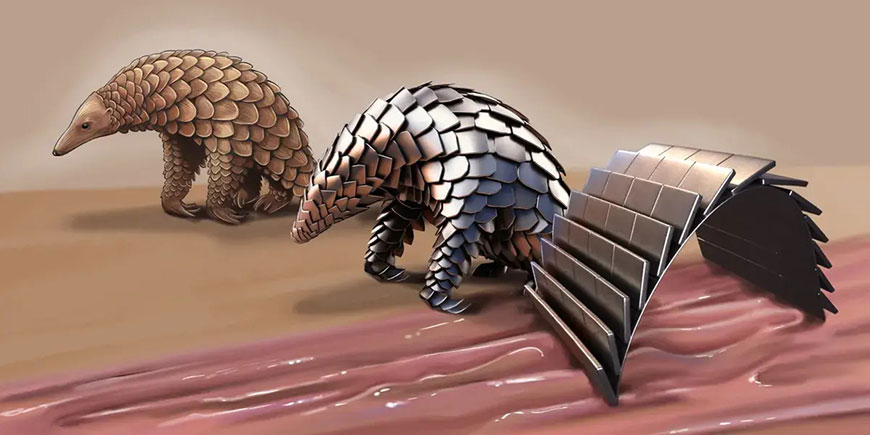A tiny pangolin-inspired robot can travel inside the human body without damaging it and perform minimally invasive medical procedures.
Nature is a constant source of inspiration for scientists and researchers who mimic animal behaviour in order to develop innovations in the field of medicine. Researchers have been inspired by the pangolin – known as a possible link between bats and humans for the Sars-Cov-2 virus – to create a new tiny medical robot.
The pangolin
The pangolin is also known as the ‘scaly anteater‘. It is the only living mammal in the order Pholydidae.
Its main characteristic is its armour plate, the keratin scales that cover its body. Only the belly, the inside of the legs, the snout and the sides of the head are uncovered. In case of danger or fear, the armour allows the Pangolin to crouch down. The scales are sharp and can be used as a weapon.

The shapes, movements and special armour of the pangolin inspired a group of scientists and researchers to create a robot for use in the medical field.
The robotic pangolin
Researchers at the Max Planck Institute for Intelligent Systems in Stuttgart, Germany, have developed a so-called ‘millirobot‘ that is 2 cm long and 1 cm wide.
![The similarity between the pangolin and the robot pangolin created by researchers [credits: https://www.nature.com/articles/s41467-023-38689-x/figures/1]](https://i0.wp.com/www.pegasoftsrl.it/wp-content/uploads/2024/05/pangolino-699x324-1.jpg?resize=699%2C324&ssl=1)
The robotic ‘creature‘ consists of two layers: a soft one made of a polymer studded with tiny magnetic particles, and a hard one made of overlapping metal elements. The design, inspired by the pangolin, consists of overlapping scales that make the robot flexible. It can change shape, move and roll.
The robot can also deliver heat on command to remote parts of the human body, such as the stomach and small intestine.
How the millirobot works
By exposing the robot to a low-frequency magnetic field, researchers can roll it up and move it back and forth.
The special feature is that although the metal elements protrude like the scales of the animal, they do not damage the surrounding tissue and can therefore be easily used inside the human body.
Once rolled up, the robot can transport particles such as medicines. This opens up the possibility of innovative treatments in hard-to-reach areas.
On the contrary, when exposed to a high-frequency magnetic field, the robot pangolin can heat up to over 70° Celsius: at this temperature, it is mainly used to treat internal bleeding, thrombosis and even tumour tissue. All by remote control, of course.
«Magnetic propulsion has emerged as a promising method for robots in biomedical applications due to the ability of the magnetic field to safely penetrate human tissue», the study says.
![Details of how the robotic pangolin, developed by researchers at the Max Planck Institute for Intelligent Systems in Stuttgart, works [credits: https://www.nature.com/articles/s41467-023-38689-x/figures/1]](https://i0.wp.com/www.pegasoftsrl.it/wp-content/uploads/2024/05/proposed-pangolin-inspired-rf-heating-mechanism-for-untethered-magnetic-robotsL.png?resize=1024%2C761&ssl=1)
The use of soft magnetic robots based on solid metals to perform less invasive medical procedures has already been demonstrated by engineers. But their medical usefulness was minimal. This is why the researchers have developed this innovative robot, which is also capable of delivering targeted drugs.
Promising laboratory tests
Although this is not the first time that scientists have turned to nature for mini-robotics, what makes this project so promising is that, until now, robots have been made of hard elements that cannot move easily inside the human body without causing damage.
However, in laboratory tests carried out by the research team, the robotic pangolin was able to pass through soft tissue without damaging it by stopping the flow of blood to stop an ongoing bleed.
This is demonstrated in the video below:
Prospects for the future
Although further testing is needed, the robotic pangolin’s ability to reach remote areas of the human body in a minimally invasive and gentle way, combined with its ability to deliver heat on demand, opens up exciting prospects for the treatment of various diseases.
«Biocompatible and biodegradable materials suitable for the work of the robot pangolin should also be considered. Addressing these issues would further enhance the robot’s capabilities and could potentially open up a new range of minimally invasive medical procedures that are not currently available. », the study says.
The study, published in the journal Nature Communications, illustrates the potential of this new, smaller robotic ‘creature’ that could revolutionise the field of medicine in the future.


